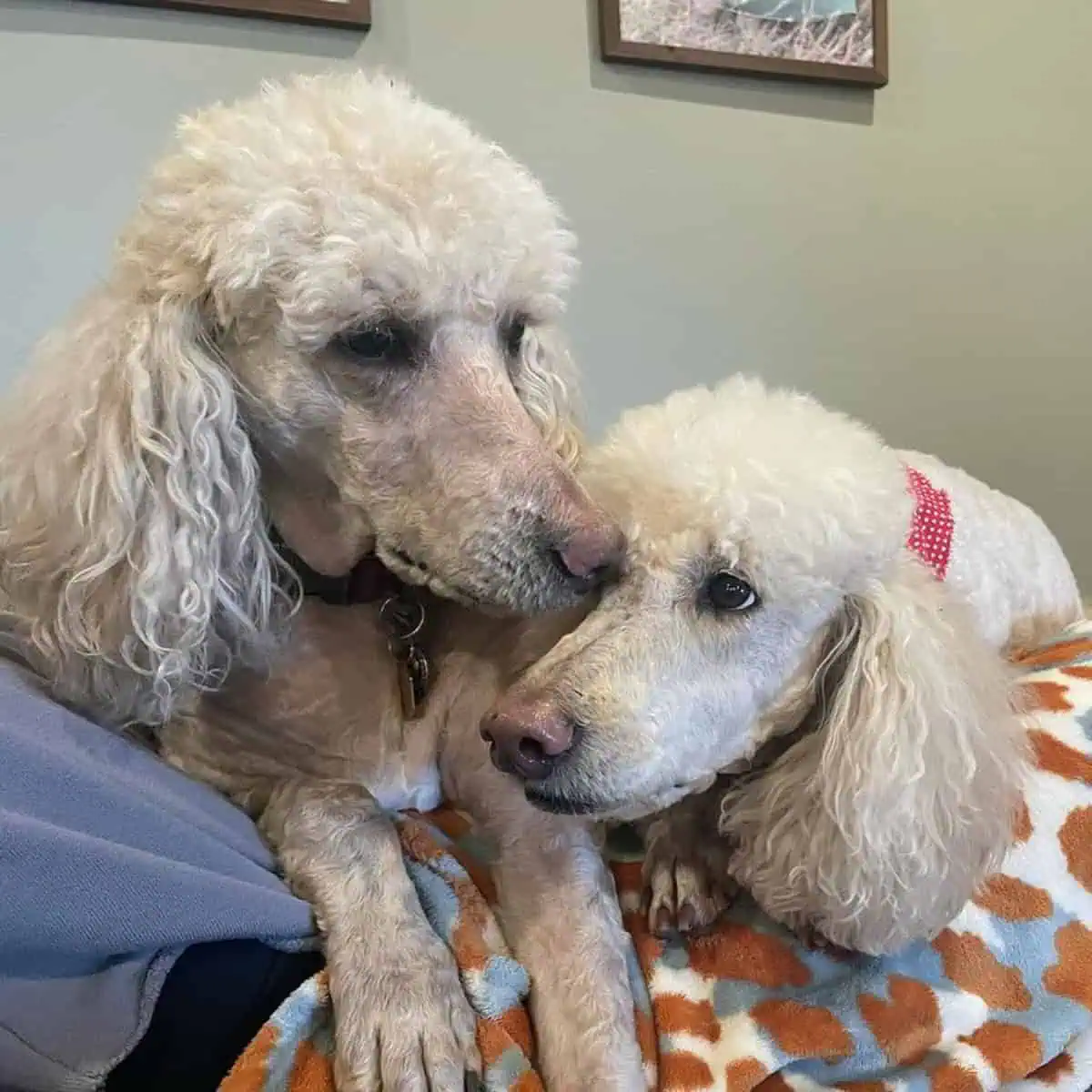When To Get a Poodle Spayed? (Age Guide)
Whether you have a Cockapoo, a Bernedoodle, or just a standard poodle, being a poodle parent is probably a highlight of your life. These adorable dogs are packed to the brim with energy and cuddly delight– and that’s why it’s so important to take care of their health.
We want them to stay in our lives for as long as possible!
According to many veterinarians, spaying your female poodle or poodle mix is one of the most important health decisions you can make for them.
In many cases, it can save your dog’s life. But the question of when specifically to start the process is much more complicated, and getting it wrong can pose serious problems for your pet.
Here, we will primarily discuss the best age to get your pet spayed, though we’ll also dive into the benefits, risks, and nuances involved in that question.
When To Get Your Poodle Spayed?
If you’re just looking for a simple answer, the American Animal Hospital Association (AAHA) recommends that most dogs get spayed between 5 and 15 months of age.
The biggest variable in deciding when precisely within that range is your poodle’s size. Almost all non-mixed poodles are in the “small-breed dog” category, meaning they weigh under 45 pounds. The AAHA recommends that dogs at that weight get spayed within 5-6 months of age, completing the procedure before their first heat.
If your poodle or poodle mix weighs over 45 pounds (this can be the case for larger poodle mix categories like Goldendoodles or Labradoodles), the range gets a little wider. Most of the time, veterinarians recommend that the process take place after the dog’s growth stops, between 9 and 15 months.
Spaying Older Poodles
If you adopted an older, intact poodle, it is almost certainly still worth getting them spayed. While the benefits will be reduced, and there may be slightly more risks entailed, it will still likely provide a much healthier life for your dog. In these cases, it’s especially important to get a veterinary consultation.

Always Talk To Your Veterinarian
We highly recommend getting your veterinarian’s opinion before making the decision to spay your poodle. It is a crucial decision– if your poodle is spayed too early, she’s at a greater risk for incontinence later in life, but she gets spayed too late, she has a greater risk of mammary cancer.

Your vet is the best person to determine the ideal time to spay your poodle so she can have the healthiest life possible.
How a Poodle Gets Spayed?
You may have heard of spaying before without knowing much about what the process entails. Fortunately for you, we have the answers!

Spaying is the process of surgically removing a female dog’s ovaries and sometimes uterus. It is quicker for the doctor to only remove the ovaries (a process called ovariectomy), even though they typically remove both the ovaries and the uterus (which is called an ovariohysterectomy).
As for the process itself, your veterinarian will first run a blood test to ensure that your pet can handle the anesthetic. If they can, the doctor will then deliver the anesthetic using an intravenous catheter (which will also offer fluid therapy while the operation takes place).
Once your poodle is sedated, the veterinarian will fit her with a breathing tube, which will both allow her to breathe and further anesthetize her. At that point, surgery will begin and the vet will perform either the ovariectomy or ovariohysterectomy.
Before and After Surgery
Make sure to check with your vet to find out if they have any requests for you caring for your dog before the surgery. Most of the time, veterinarians will request that you refrain from giving your dog any food after 10 PM the night before– sometimes, the anesthetic can induce vomiting, and we all want to avoid that!

After the surgery, you are in charge of taking care of your poodle. She will need about two weeks to recover, and there are vital tasks to complete during this period:
- Do not forget to give your poodle her medication. She won’t need medication during the whole recovery period. Depending on the procedure, it likely will only be needed up to a few days after the surgery.
- Keep your pet as calm and quiet as you can. If you allow her to jump around, it will cause problems for her stitches.
- Prevent your dog from licking her stitches. If you’re having trouble with this, many dog parents find cones to be helpful.
- Do not give your pet any baths during the recovery period.
- During the recovery period, your poodle should only go outside to use the bathroom or for really brief walks.
- Keep an eye on your poodle. If her incision starts to smell, if you see any discharge around the incision area, or if you’re finding any other problems: contact your veterinarian.
Benefits of Spaying Your Poodle
There’s one obvious benefit to spaying your pet: you won’t need to deal with unwanted pregnancies. Unwanted pet pregnancies can be dangerous, expensive, and challenging to manage, so avoiding them is reason enough for most pet parents to go forward with spaying their dogs. But there are a plethora of unexpected benefits that go beyond that.
Avoiding Pregnancy
Many poodle parents don’t think through all the positive implications of avoiding your dog’s pregnancy.

Spayed poodles won’t feel the need to roam and look for a mate, which makes them much more likely to stay home. This greatly reduces the risk of:
- Traumatic outdoor accidents like car accidents
- Contagious diseases contracted from exploring unsafe outdoor areas
- Injuries from getting in fights with other animals
- Getting lost and picked on by predators or dog thieves
You won’t need to deal with stray male dogs camping in your yard.
- Male dogs can pick up the scent of a female dog in heat from up to a mile away.
- If a stray male picks up your pet’s scent and wants to mate with her, he will often stick around in your yard, causing problems for you, your household, and your pet.
- Strays are often more aggressive than domestic dogs and pose a genuine safety risk to people (and pets!) coming in and out of your home.
Your poodle’s estrous cycle will be a non-issue.
- A non-spayed female dog’s estrous cycle can last up to 15 days and takes place twice a year.
- During it, your poodle will be passing bloody fluids all over your home and crying frequently. This combination of bloody fluid and consistent noise often poses significant stress for dog parents.
Dog overpopulation is a significant existing problem, and shelters are stressed enough as is. Spaying your poodle can reduce these numbers significantly. The Poodle Club points out that only a dog intended to breed needs to remain unspayed.
Further Health Benefits
Because your poodle will not have any ovaries, spaying her eliminates the chance of ovarian cancer.

The process also eliminates the chance of uterine cancer if you remove the uterus as well.
Spaying significantly reduces rates of mammary cancer and almost eliminates the chance of contracting pyometra
Pyometra is a disease that often afflicts intact female dogs (some studies have found that it affects 25% of intact female poodles) and usually requires emergency surgery to remedy. In some cases, it can be fatal.